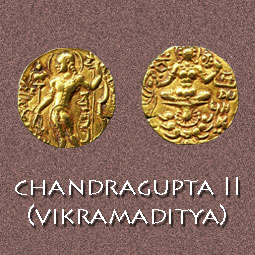Considering the vastness of Indian Numismatics, it is very important for young collectors to break it down into basic categories so that it becomes much easier to explore the enormous varieties of Indian coins. If you are looking for the right start, then read on, this is the perfect snapshot for you!
Ancient Coins of India:
In the 6th Century BCE, the Indian subcontinent was divided into 22 different Janapadas and each Janapada issued coins of their own. Ancient Indian coin issued by Gandhara Janapada are considered to be some of the earliest coins of the world. These were rectangular silver coin which featured a six-armed symbol at both ends of one side. The other side of these ancient coins of India was left blank. These historic coin were minted using the punch-marked technique. Coming to ancient Indian empires and kingdoms, the Gupta Empire issued some of the most beautiful coins in India from 320 AD to 550 AD. When it comes to South India, Cholas, Cheras, Pandyas and Pallavas were some of the most powerful dynasties who also issued various types of ancient Indian coin. Then came the coins of Ancient Invaders like Greco-Bactrian, Indo-Greeks, Indo-Scythian, Kushans, Indo-Parthians etc. These amazing coins depict the unique cultures and traditions that these invaders followed.Medieval India Coins:
When we talk about Indian coins, nobody can miss out on the wonderful coin that were issued by powerful and legendary emperors such as Akbar, Shivaji Maharaj, Tupu Sultan etc. Medieval India coin can be broadly classified into five major groups. Coin issued by the Sultans, the Mughals, Independent Kingdoms, Princely States and Hindu Kingdoms. Coins issued by the Sultans and Mughals featured Persian legends. Some of them even featured beautiful couplets like the ones issued by the Mughal Emperor Jahangir. Coins issued by Shivaji Maharaj were called as Shivrai. Introducing a new denomination at a time when the Mughals were extremely powerful is considered to be a great achievement. During Shivaji Maharaj's coronation, special Shivrai coins were minted in gold. These gold coin are extremely rare and are sold at auction houses all across the globe.Colonial India Coins:
After the decline of the Mughal Empire, several European powers started exploiting trading opportunities in India. The most successful of them was the British East India Company who gradually started imposing their power and eventually, India was declared as the official colony of Britain. Initially, coins in India were issued by the East India Company for different circles like the Bengal Presidency, Bombay Presidency and Madras Presidency. After the revolt of 1857, British India coin were officially issued under the Queen's reign. These amazing colonial coin featured a portrait of the Queen or King on one side with the denomination an year of issue on the other side. Apart from British East India Company, several other trading companies like the Dutch East India Company, Danish East India Company, French East India Company and Portugal also issued different kinds of coins in India.Republic India Coins:
Finally, Republic India coins are the ones that are issued by the Government of India after independence in 1947. Old British India coin were circulated as frozen currency until the first coin of republic India were issued in the year 1950. These Indian coins belonged to the Anna Series. Some of them were struck in different shapes like Square and Scalloped. The decimal coinage was adopted in the year 1957, after which both decimal as well as pre-decimal coin were circulated together for a short period of time. The 2 pice coins issued between 1957 and 1964 featured the legend "Naya Paisa" to differentiate them with the ones of the same denomination that were issued earlier.The history of Indian coin is so vast that it is impossible to learn everything at one go. You will have to select a category and then dive deep into it, by covering one dynasty/ kingdom at a time. By following this procedure, you will get a fair idea about our glorious past.
Simplify the study of Coins of India by exploring the broad categories of Indian coinage in brief. If you are looking to pursue Indian numismatics seriously, this article is exactly what you need to get started. Understand the basics of Indian coinage so that you can research about the innumerable varieties of coins systematically.






















